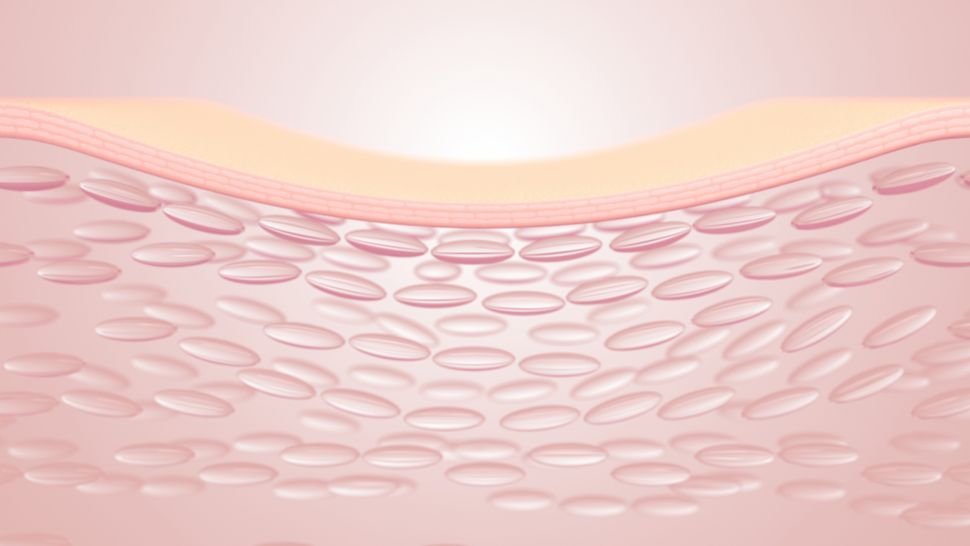Connective tissue diseases are a group of conditions that cause tissue inflammation and damage. These diseases are usually the result of autoimmune reactions and are chronic in nature. They often affect different organs, and this can lead to serious health problems and even death.
The main connective tissue diseases include: systemic lupus erythematosus (SLE), scleroderma and rheumatoid arthritis (RA). This group also includes Sjogren’s syndrome, mixed connective tissue disease (Sharp’s disease, MCTD) and polymyositis.
In this article, we will review connective tissue diseases, including their pathophysiology, symptoms, causes, risk factors, diagnosis, and treatment options.
General characteristics of connective tissue diseases
Connective tissue diseases (CTDs) are a group of diseases that affect the tissues responsible for supporting, connecting or separating various organs and structures in the body. These tissues include skin, fat, muscle, cartilage, and blood vessels, which play a key role in maintaining the structural integrity and function of various systems in the body.
Often these diseases are associated with autoimmune processes, in which the immune system mistakenly attacks its own connective tissues. This leads to inflammation and damage to the affected tissues. Chronic inflammation and subsequent damage contribute to the appearance of various symptoms and complications characteristic of these diseases.
Types of connective tissue diseases
- Systemic lupus erythematosus (SLE): This is a chronic autoimmune disease in which the immune system attacks its own tissues and organs. Lupus can affect multiple organs and systems, including the skin, joints, kidneys, heart, lungs, and brain. Symptoms vary but often include fatigue, joint pain, rashes and kidney problems.
- Scleroderma: The disease is characterized by excessive growth and accumulation of connective tissue, which leads to hardening and tightening of the skin and internal organs. Scleroderma can be limited to the skin or it can also affect internal organs such as the lungs, heart and kidneys. Depending on the severity, it can lead to significant complications.
- Rheumatoid arthritis (RA): This is a chronic inflammatory disease that primarily affects the joints, causing inflammation, pain, swelling, and bone erosion. Over time, it can lead to joint deformity and loss of function. In addition to the joints, RA can affect other parts of the body, including the heart, lungs, and blood vessels.
Other connective tissue diseases:
- Sjögren’s syndrome: This is an autoimmune disease in which the immune system attacks glands such as the salivary and lacrimal glands. This leads to dry mouth and eyes, but can also affect other organs such as the kidneys and lungs.
- Mixed connective tissue disease (MCTD): This is a condition in which the patient exhibits symptoms of at least two other connective tissue diseases such as systemic lupus erythematosus, scleroderma, and polymyositis. It is characterized by overlapping symptoms that can make diagnosis difficult.
- Polymyositis: This is an inflammatory disease of the muscles that causes muscle weakness and inflammation. It usually affects the muscles around the shoulders and pelvis and can make movements such as standing up, lifting objects or climbing stairs difficult. In some cases, it can also affect the lungs or heart.
Characteristic symptoms of connective tissue diseases
- Joint pain and swelling: Joint-related symptoms predominate in most connective tissue diseases. Conditions such as rheumatoid arthritis and lupus usually present precisely with joint pain and swelling, causing chronic discomfort and mobility problems.
- Skin changes: People who suffer from connective tissue diseases often experience rashes, thickening and discoloration of the skin.
- Fatigue: Chronic fatigue and malaise are widespread and debilitating symptoms of connective tissue disease. Fatigue can seriously affect daily activities and overall quality of life, turning even simple tasks into exhausting and challenging endeavors.
- Raynaud’s syndrome: Raynaud’s syndrome involves episodes of reduced blood flow to the fingers and toes caused by cold or stress. This results in discoloration, pain, and numbness in the affected areas.
- Organ involvement: Connective tissue diseases can affect multiple organs, leading to severe complications. Lung problems such as interstitial lung disease, kidney problems such as lupus nephritis, and heart complications including pericarditis and myocarditis are common. These organ involvements require careful monitoring and management to prevent long-term disability.
Common reasons for the development of connective tissue diseases
Connective tissue diseases develop as a result of a complex interaction between genetic, environmental and hormonal factors.
- Genetic predisposition plays a key role, as certain genes related to the immune system can increase the risk of these diseases.
- Environmental factors, such as infections and medication, can also trigger autoimmune reactions that lead to connective tissue diseases.
- Hormonal factors also influence the development of these diseases. For example, diseases such as systemic lupus erythematosus (SLE) are nine times more common in women, scleroderma affects three times more women, and rheumatoid arthritis occurs in 71% of women. The higher incidence in women is probably related to estrogen influencing immune responses.
Risk factors
Various factors increase the likelihood of developing connective tissue diseases. Understanding these factors is key to the prevention and early treatment of these diseases.
Family history
A family history of autoimmune or connective tissue diseases greatly increases the risk of developing these conditions. Genetic factors can make people more vulnerable to diseases such as rheumatoid arthritis (RA), systemic lupus erythematosus (SLE), and scleroderma.
Age and gender
Age and gender are important factors that influence the risk of developing connective tissue diseases. Many of these conditions are more common in women and usually appear between the ages of 30 and 45. Hormonal differences related to estrogen contribute to the increased risk in women.
Other risk factors
Other risk factors include smoking , which can worsen conditions such as RA and scleroderma. Exposure to certain chemicals such as silica and solvents, as well as ultraviolet (UV) light, has also been associated with an increased risk of autoimmune diseases. Chronic stress can cause or worsen symptoms because it affects immune system function and inflammation levels in the body.
What are the treatment options for connective tissue diseases?
Treatment of connective tissue diseases includes several approaches: drug therapy, lifestyle changes, and supportive therapies.
Drug therapy
Drug therapy for connective tissue diseases includes various drugs that relieve symptoms and control the progression of the disease. Nonsteroidal anti-inflammatory drugs (NSAIDs) are effective in reducing pain and inflammation in joints and muscles. Corticosteroids, as powerful anti-inflammatory agents that quickly control severe symptoms, but require careful monitoring for long-term use. In severe cases, immunosuppressants are used, which regulate the immune system and prevent damage to healthy tissues.
Lifestyle changes
- Diet: A balanced diet rich in anti-inflammatory foods such as fruits, vegetables, omega-3 fatty acids and whole grains is recommended. Avoiding processed foods, sugar, and saturated fat can also help reduce inflammation.
- Exercise: Regular physical activity is important for maintaining joint mobility and overall health. Exercise also reduces fatigue and improves mental well-being.
- Stress management: Stress reduction techniques can help reduce flare-ups and improve overall quality of life.
Supportive therapies
- Physical therapy: Plays an important role in maintaining joint function and mobility. Physical therapists create customized programs that strengthen muscles and improve joint function.
- Occupational therapy: Helps people cope with daily activities and maintain their independence. Occupational therapists offer adaptive techniques that facilitate daily tasks and improve quality of life.
Sources:
- Benjamin, O., Goyal, A., & Lappin, SL (2022, July 4). Disease Modifying Anti-Rheumatic Drugs (DMARDs). PubMed; StatPearls Publishing. https://www.ncbi.nlm.nih.gov/books/NBK507863/
- Bouomrani, S. (2019). Rehabilitation in Connective Tissue Diseases. Examines in Physical Medicine & Rehabilitation, 2(4). https://doi.org/10.31031/epmr.2019.02.000545
- Cedars Sinai. (n.d.). Connective Tissue Diseases. Cedars-Sinai. https://www.cedars-sinai.org/health-library/diseases-and-conditions/c/connective-tissue-disorders.html
- Cleveland Clinic. (2019a, April 2). Polymyositis: Symptoms, Causes & Treatments. Cleveland Clinic. https://my.clevelandclinic.org/health/diseases/12053-polymyositis
- Cleveland Clinic. (2019b, December 16). Connective Tissue Disease: Types, Diagnosis, Symptoms & Causes. Cleveland Clinic. https://my.clevelandclinic.org/health/diseases/14803-connective-tissue-diseases
- Cleveland Clinic. (2021, April 19). Systemic Lupus Erythematosus: Causes, Treatments. Cleveland Clinic. https://my.clevelandclinic.org/health/diseases/4875-lupus
- Cleveland Clinic. (2023, June 13). CT Scan (Computed Tomography): What is It, Preparation & Test Details. Cleveland Clinic. https://my.clevelandclinic.org/health/diagnostics/4808-ct-computed-tomography-scan
- Cloyd, J. (2023a, February 21). A Functional Medicine GERD Protocol. Rupa Health. https://www.rupahealth.com/post/a-functional-medicine-gerd-protocol
- Cloyd, J. (2023b, March 29). 10 Differential Diagnosis for Fatigue: Testing & Integrative Treatment Recommendations. Rupa Health. https://www.rupahealth.com/post/10-differential-diagnosis-for-fatigue
- Cloyd, J. (2023c, July 13). A Functional Medicine Raynaud’s Syndrome Protocol: Testing, Therapeutic Diet, and Supplements. Rupa Health. https://www.rupahealth.com/post/a-functional-medicine-raynauds-syndrome-protocol-testing-therapeutic-diet-and-supplements


